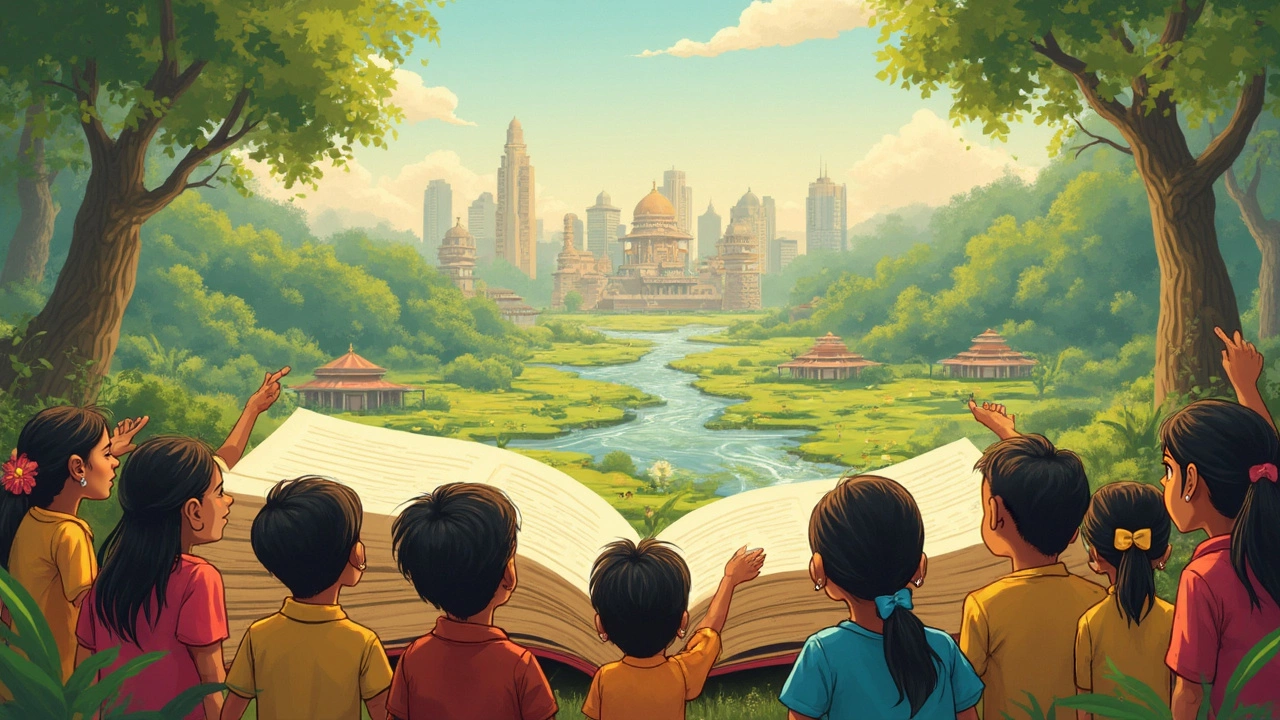It's tempting to lump everything green and outdoorsy into one big 'environment' bucket. But that doesn't really cut it if you want to understand how the world works—and what needs protecting. The environment has specific groups, and each one works a bit differently. These aren't just science textbook pages; they're the stuff that shapes your city, your summers, and even the air you breathe at home.
Scientists and activists separate environments into a few main groups to keep things clear and organized. It makes sense—the way you'd sort your laundry before tossing it in the wash. Ever heard the terms 'natural environment' and 'built environment'? That's just the starting point. Figuring out the main categories helps you spot problems and pitch in real solutions, whether you care about ocean plastic or neighborhood parks.
Here’s the deal: if you get familiar with these groups, you see new ways to cut waste, save energy, or just enjoy nature without making a mess. Keep reading and you’ll get practical ideas you can actually use, plus a couple of facts you'll want to share next time someone brings up climate or city design at dinner.
- Defining the Main Environmental Groups
- Natural Groups: Land, Water, and Air
- Human-Made Environments
- Why Knowing These Groups Matters
Defining the Main Environmental Groups
This is where things start to make sense. When you hear about the environment, people usually mean a specific group—and yep, there are a few main ones. Experts around the world divide the environment into two big zones: natural and human-made. It’s not complicated, but it helps sort out messy debates when someone argues about saving the rainforest versus building more houses.
The environmental groups you’ll run into most often include:
- Natural Environment: Everything not made or altered by humans. Think forests, oceans, rivers, deserts, grasslands, and the air above us.
- Human-Made (Built) Environment: Cities, roads, farms, factories—anything that humans have designed, built, or changed significantly.
- Social Environment: The invisible network—families, cultures, and communities—that shapes how we interact with the natural and built environments. It’s not physical, but it makes a difference in how people treat the planet.
Some folks dig even deeper, dividing each group into more specific chunks like 'aquatic environments' (oceans, lakes, wetlands) or 'urban environments' (city centers, suburbs, industrial parks). But the main split is between what’s natural and what we’ve changed.
It’s not just talk either. Here’s a straightforward table showing what usually gets slotted into each group:
| Environmental Group | Examples |
|---|---|
| Natural | Mountains, forests, rivers, oceans, atmosphere |
| Human-Made | Cities, farmlands, highways, buildings, playgrounds |
| Social | Neighborhoods, cultures, social habits, community rules |
Why split things up like this? Without these groups, no one would know if a piece of news about "the environment" means fish in a river or new bike lanes in the city. It also helps activists and leaders focus on what needs fixing or protecting next, whether it’s a wildlife reserve or urban pollution controls.
Natural Groups: Land, Water, and Air
Most everyday things fit into three main natural groups: land, water, and air. Each plays a role in keeping our planet balanced—and they’re more connected than you might think.
Start with land. This includes forests, deserts, grasslands, mountains, and even your local park. Soil does more than just let you grow tomatoes. It supports half of all life on Earth. Forests alone store about 80% of land animals and plants. When land gets damaged by chopping down trees or building nonstop, it throws off food chains and water cycles fast.
Water covers around 70% of the Earth’s surface and comes in fresh and salty forms. Think oceans (which hold about 97% of all water), lakes, rivers, and even tiny streams behind your house. Oceans alone feed more than a billion people with fish and other sea life. But when water gets polluted by plastic or chemicals, it’s a straight shot to unhealthy wildlife—and less clean water for everyone.
Air is the most invisible group, but it’s everywhere. The atmosphere acts like a giant blanket, shielding us from the sun’s harshest rays and keeping things just the right temperature. It’s got gases like oxygen for breathing and carbon dioxide for plants. The problem? Air pollution doesn’t care about borders. Dirty air from one city can float across whole continents. Besides health issues, air pollution makes climate change even worse.
Simple tips for keeping these groups healthy include:
- Reduce your plastic use—it keeps garbage out of land and water.
- Join a local tree planting—forests stay stronger, air gets cleaner.
- Avoid using harsh lawn chemicals—these often wash straight into rivers and lakes.
- Use public transport or bike—less exhaust means cleaner air.
If you pay attention to how these environmental groups connect, it gets easier to spot real ways to help out. Every small change matters, especially when it protects land, water, or air near you.

Human-Made Environments
Take a look out your window. Chances are, you’re looking at a human-made environment—sometimes called the built environment. We’re talking houses, offices, factories, roads, even parks that have been planned and built by people. While these places can look green and relaxing, they’re very different from untouched forests or wild rivers. The whole idea is that human-made environments shape how we live, move, and even what we breathe.
Let’s get concrete. Cities make up just about 3% of Earth’s land, but more than half the planet’s people live in them. Urban areas change the game: energy use skyrockets, waste piles up, and natural habitats get squeezed out. For example, the United Nations says cities use about 78% of the world’s energy and pump out over 60% of greenhouse gas emissions. Even little stuff like how we design sidewalks or bike lanes affects not just our health, but air quality too.
Human-made environments aren’t all the same. Here’s how they usually break down:
- Urban environments: Cities and towns, loaded with buildings, roads, shopping centers, and dense populations.
- Suburban environments: Mixes of homes and businesses, usually with more green space and cars than city centers.
- Industrial zones: Factories, warehouses, and plants—these areas focus on production, often at the expense of open land.
- Rural built areas: Small villages, farming setups, and scattered homes in the countryside.
And then you have all the stuff that comes with these places—electric wires, water pipes, garbage systems, public parks, train stations, and even shipping ports. Each piece helps people live more comfortably, but it can harm natural resources if not handled smartly.
Check out some real numbers to see how things stack up:
| Type | Average Land Use (%) | Main Impact |
|---|---|---|
| Urban | 3 | High energy use, pollution |
| Suburban | 8 | Car dependency, spread-out growth |
| Industrial | 2 | Waste, water/air contamination |
| Rural Built | 12 | Low density, often resource extraction |
What can you actually do, living in a human-made space? Try these:
- Choose public transport, walking, or biking instead of driving everywhere.
- Support local urban gardens or start your own—green spaces are a big win.
- Push for better recycling and waste programs in your neighborhood.
- Vote (and speak up) for policies that boost clean energy and protect city trees.
The key takeaway: environmental groups aren’t just out in the wild, they’re also shaping the places where we live and work. Understanding how human-made environments function means you’ll spot new ways to make your corner of the world better—without needing a science degree.
Why Knowing These Groups Matters
If you’ve ever scrolled through news about wildfires, water shortages, or city air pollution, you’ve seen how different environmental groups face very different problems. Knowing the main types—like land, water, air, and human-made spaces—tells you where something’s going wrong or right. You can’t solve a water pollution problem by only cleaning up city parks, right?
Take cities as an example. Urban environments are home to over 55% of the world’s population as of 2024, and that number’s still climbing. These areas create lots of air pollution, but they also have their own green fixes, like rooftop gardens and public transit. Forests, on the flip side, are natural carbon sinks, pulling carbon dioxide out of the atmosphere and helping fight climate change. Each group calls for its own solutions and challenges.
This is more than science class stuff. Here are some things you can do once you know the differences:
- Focus your recycling efforts where they matter most—like plastics for water environments and electronics for urban areas.
- Support policies that protect specific environments, such as urban tree planting or wetland restoration. One-size-fits-all rarely works.
- Understand local risks. If you live near rivers, flood prevention might matter more to you than wildfire defense.
Here’s a snapshot of environmental groups and a real-world worry each one faces:
| Environment Group | Major Challenge | Key Fact |
|---|---|---|
| Natural (Land) | Deforestation | Over 10 million hectares of forest lost yearly (FAO 2023) |
| Natural (Water) | Plastic Pollution | 11 million tons of plastic enter oceans every year |
| Atmosphere | Air Quality | 99% of people breathe air with pollution above WHO guidelines |
| Urban (Built) | Resource Use | Cities use 78% of the world’s energy |
Want to make an impact? The trick is knowing which group needs what. Without this knowledge, efforts get scattered. But when you understand the environmental groups and their biggest issues, your time, money, or action goes exactly where it helps most. That’s why the details really matter.
